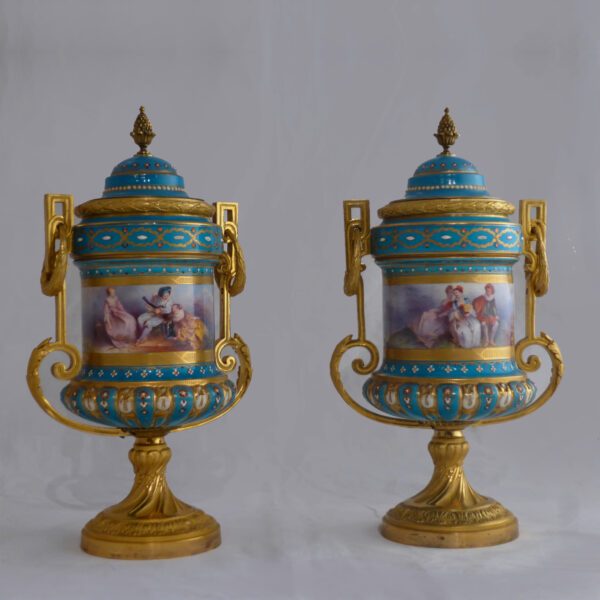Sèvres (Style)
A Fine Pair of Gilt-Bronze Mounted Cobalt Blue Sèvres Style Porcelain Vases and Covers
£35,000
A Fine Pair of Gilt-Bronze Mounted Cobalt Blue Sèvres Style Porcelain Vases and Covers. Each vase is of amphora form with domed covers, scrolled handles...
Dimensions
Height: 105 cm (42 in)Width: 37 cm (15 in)
Depth: 26 cm (11 in)
Description
A Fine Pair of Gilt-Bronze Mounted Cobalt Blue Sèvres Style Porcelain Vases and Covers.
Each vase is of amphora form with domed covers, scrolled handles and square section re-entrant gilt-bronze plinth bases. The body of each vase is of cobalt blue ground enriched with fine gilt tooling and centred to the front with a finely painted cartouche of a pastoral scene in the eighteenth century manner of Watteau and to the reverse with a landscape. The inside of each cover inscribed in underglaze red ‘Offert par le Duc de Richelieu a Madame Campan’, under interlaced ‘L’s’ in blue.
French, Circa 1890.
Date
Circa 1890
Origin
French
Medium
Gilt-Bronze and Porcelain
Signature
Inscribed in underglaze red 'Offert par le Duc de Richelieu a Madame Campan' | under interlaced 'L's' in blue.
The Sèvres Porcelain Manufactory was founded to the east of Paris in the disused Royal Château of Vincennes, late in 1739-40. and moved to the village of Sèvres, west of Paris in 1756, en route to King Louis XV’s palace of Versailles.
Here it was also adjacent to Louis’s mistress Madame de Pompadour’s own château at Bellevue. She was delighted with the factory’s new location – as she knew she could entice Louis to take a greater interest in it when it was so near their own residences. Indeed, the King became such a keen patron of the factory that, when it ran into financial difficulties, he bought out the shareholders and became the sole proprietor. The factory remained a royal enterprise until the French Revolution, when it was nationalised.
The popularity of the Louis XV style during the nineteenth century led to a number of companies in and around Paris, creating exceptional Sèvres-Style porcelain based on eighteenth century models and to the same exceptional quality. Often these pieces were of exhibition quality and scale, and finely painted by the best studio painters of the day such as Robert, Desprez and Poitevin.
























 Print
Print


